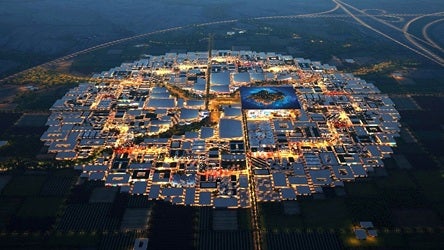Iraq forecast dips on lower oil prices
29 May 2025

MEED’s June 2025 report on Iraq includes:
> COMMENT: Iraq maintains its pace, for now
> GOVERNMENT & ECONOMY: Iraq’s economy faces brewing storm
> OIL & GAS: Iraqi energy project value hits decade-high level
> PIPELINES: Revival of Syrian oil export route could benefit Iraq
> POWER: Iraq power sector turns a page
> CONSTRUCTION: Iraq pours billions into housing and infrastructure projects
Exclusive from Meed
-
 Saudi Arabia names Expo 2030 Riyadh Company CEO
Saudi Arabia names Expo 2030 Riyadh Company CEO23 June 2025
-

-

-
 PIF firm prepares Pirelli tyre plant contract award
PIF firm prepares Pirelli tyre plant contract award23 June 2025
-
 Bahrain opens highway consultancy bids
Bahrain opens highway consultancy bids23 June 2025
All of this is only 1% of what MEED.com has to offer
Subscribe now and unlock all the 153,671 articles on MEED.com
- All the latest news, data, and market intelligence across MENA at your fingerprints
- First-hand updates and inside information on projects, clients and competitors that matter to you
- 20 years' archive of information, data, and news for you to access at your convenience
- Strategize to succeed and minimise risks with timely analysis of current and future market trends

Related Articles
-
 Saudi Arabia names Expo 2030 Riyadh Company CEO
Saudi Arabia names Expo 2030 Riyadh Company CEO23 June 2025
Saudi sovereign wealth vehicle the Public Investment Fund (PIF) has named Talal Al-Marri as the CEO to lead the newly-launched Expo 2030 Riyadh Company (ERC).
In an official statement published by the Saudi Press Agency, the PIF said that Al-Marri "is expected to lead the Expo 2030 Riyadh team in delivering a world-class exhibition that reflects the kingdom’s ambitions and rapid development, in alignment with the objectives of Saudi Vision 2030".
Al-Marri has previously held several senior executive roles at Saudi Aramco, including president and CEO of Aramco Europe, senior vice president of community services and senior vice president of industrial services.
The announcement follows the establishment of ERC as a wholly-owned subsidiary of the PIF that will build and operate facilities for Expo 2030.
In a statement, the PIF said: “During its construction phases, Expo 2030 Riyadh and its legacy are projected to contribute around $64bn to Saudi GDP and generate approximately 171,000 direct and indirect jobs. Once operational, it is expected to contribute approximately $5.6bn to GDP.”
The masterplan for Expo 2030 Riyadh encompasses an area of 6 square kilometres, making it one of the largest sites designated for a World Expo. Situated to the north of the city, the expo site will be located near the future King Salman International airport, providing direct access to various landmarks within the Saudi capital.
Countries participating in Expo 2030 Riyadh will have the option to construct permanent pavilions, contributing to the event's legacy. This initiative is expected to create opportunities for business and investment growth in the region.
The expo is projected to attract over 40 million visitors. After the event concludes, ERC plans to convert the expo's secured area into a global village, to serve as a multicultural centre for retail and dining. This development will also include an international residential community with various amenities, with a focus on sustainable tourism practices.
Expo 2030 Riyadh will run from 1 October 2030 to 31 March 2031.
In mid-May, MEED reported that Riyadh had begun talks with stakeholders in preparation for the start of the construction works for the event.
The discussions were understood to have been held with the Royal Commission for Riyadh City and the PIF.
German architectural firm Lava Architects and US-based engineering firm Jacobs are assisting with the project masterplan and the design of infrastructure for the site.
 READ THE JUNE 2025 MEED BUSINESS REVIEW – click here to view PDF
READ THE JUNE 2025 MEED BUSINESS REVIEW – click here to view PDFGulf accelerates AI and data centre strategy; Baghdad keeps up project spending, but fiscal clouds gather; Banking stocks rise despite lower global oil prices
Distributed to senior decision-makers in the region and around the world, the June 2025 edition of MEED Business Review includes:
> AGENDA 1: Data centres churn investments> AGENDA 2: Gulf seizes AI opportunities> MEED TOP 100: Middle East stocks defy lower oil prices> SAUDI ARABIA: Riyadh confirms capital expenditure cuts> INTERVIEW: Mena crucial to Veolia’s growth plan> GULF PROJECTS INDEX: Gulf projects index leaps 4.3%> CONTRACT AWARDS: Region sees third month of weak awards activity> ECONOMIC DATA: Data drives regional projects> OPINION: Dealmaking trumps the Truman DoctrineTo see previous issues of MEED Business Review, please click herehttps://image.digitalinsightresearch.in/uploads/NewsArticle/14116512/main.jpg -
 Adnoc prepares tender for next Upper Zakum field expansion
Adnoc prepares tender for next Upper Zakum field expansion23 June 2025

Register for MEED’s 14-day trial access
Adnoc Offshore is preparing to start the tendering process for the next expansion phase of the Upper Zakum field development in Abu Dhabi, the objective of which is to increase the asset’s oil production potential to 1.5 million barrels a day (b/d).
MEED reported in November that the offshore oil and gas production business of Abu Dhabi National Oil Company (Adnoc Offshore) had awarded a contract for pre-front-end engineering and design (pre-feed) and feed services on the project to France-headquartered contractor Technip Energies.
A kick-off meeting between Adnoc Offshore and Technip Energies took place on 21 November, it was previously reported.
Pre-feed and feed works on the project, which is known as UZ 1.5MMBD, are in an advanced stage, according to sources. “Adnoc Offshore could be expected to issue the main engineering, procurement and construction (EPC) tender as early as July,” one source said.
Located 84 kilometres offshore in Abu Dhabi, Upper Zakum is the world’s second-largest offshore oil field and fourth-largest oil field.
The UZ 1.5MMBD project is the latest crude output expansion project that Adnoc Offshore has undertaken at the Upper Zakum field development.
Upper Zakum expansion
The first phase of the programme to raise the Upper Zakum offshore field development’s oil production capacity to 1.2 million b/d was launched in 2019. The initial goal was to increase the field’s output potential to 1 million b/d by 2024, which was later increased to 1.2 million b/d, with the project execution timeline eventually extended.
In April last year, MEED reported that Adnoc Offshore had awarded the main EPC contract for the UZ 1.2MMBD EPC-1 project to UAE-based Target Engineering Construction Company. The value of the contract was estimated to be $825m.
The project’s main scope involves the EPC of several surface facilities and plants at the Upper Zakum offshore development’s four main artificial islands: Al-Ghallan, Umm Al-Anbar, Ettouk and Asseifiya – also known as Central Island, West Island, North Island and South Island, respectively.
Spanish contractor Tecnicas Reunidas won the contract for the feed works on the UZ 1.2MMBD EPC-1 project in 2019. UK-headquartered Wood Group was appointed as the project management consultant for the EPC phase.
In November, MEED reported that Adnoc Offshore had also selected Target for the second phase of the Upper Zakum 1.2 million b/d project (UZ 1.2MMBD EPC-2). The value of the contract was estimated to be about $500m, according to sources.
Target began work on the project in December, MEED previously reported.
The scope of work on the UZ 1.2MMBD EPC-2 project covers the EPC of several structures on Assefiya Island.
Adnoc Offshore performed the feed work on the UZ 1.2MMBD EPC-2 project in-house.
Upper Zakum oil production
Adnoc Offshore has committed to a total capital expenditure budget of approximately $30bn, along with its operating partners in the Upper Zakum hydrocarbons concession, Japan Oil Development Company (Jodco) and US-based ExxonMobil.
The strategic objective is to first raise the asset’s oil output from 640,000 b/d to 750,000 b/d through the UZ 750 project, then to 1.2 million b/d through the two phases of the ongoing UZ 1.2MMBD project, and eventually to 1.5 million b/d.
Zakum Development Company (Zadco), which later merged into Adnoc Offshore, awarded EPC contracts for the UZ 750 project in 2012 and early 2013.
The $817m first package was awarded to a consortium of Abu Dhabi’s NMDC Energy (then known as National Petroleum Construction Company) and Technip Energies. Package two, the project’s largest EPC package, worth $3.7bn, was awarded to a consortium of UK-headquartered Petrofac and South Korea’s Daewoo Shipbuilding & Engineering.
EPC work on UZ 750 began in 2014 and was completed in 2022.
In October 2022, Adnoc Group subsidiary Adnoc Drilling set a world record for drilling the longest oil and gas well at the Upper Zakum concession, stretching 50,000 feet.
The extended-reach wells will tap into an undeveloped part of the Upper Zakum reservoir, potentially increasing the field’s production capacity by 15,000 b/d without expanding or building any new infrastructure, Adnoc said.
ALSO READ: Adnoc signs $60bn of agreements with US companies
 READ THE JUNE 2025 MEED BUSINESS REVIEW – click here to view PDF
READ THE JUNE 2025 MEED BUSINESS REVIEW – click here to view PDFGulf accelerates AI and data centre strategy; Baghdad keeps up project spending, but fiscal clouds gather; Banking stocks rise despite lower global oil prices
Distributed to senior decision-makers in the region and around the world, the June 2025 edition of MEED Business Review includes:
> AGENDA 1: Data centres churn investments> AGENDA 2: Gulf seizes AI opportunities> MEED TOP 100: Middle East stocks defy lower oil prices> SAUDI ARABIA: Riyadh confirms capital expenditure cuts> INTERVIEW: Mena crucial to Veolia’s growth plan> GULF PROJECTS INDEX: Gulf projects index leaps 4.3%> CONTRACT AWARDS: Region sees third month of weak awards activity> ECONOMIC DATA: Data drives regional projects> OPINION: Dealmaking trumps the Truman DoctrineTo see previous issues of MEED Business Review, please click herehttps://image.digitalinsightresearch.in/uploads/NewsArticle/14115851/main5852.jpg -
 Beltone Leasing secures $20m funding from German investor
Beltone Leasing secures $20m funding from German investor23 June 2025
Register for MEED’s 14-day trial access
Beltone Leasing & Factoring has signed a $20m funding agreement with Germany-based Finance in Motion to expand lending to small businesses and support green finance initiatives across the Middle East and North Africa (Mena).
The funding is evenly split between two investment vehicles: $10m from the Sanad Fund for micro, small and medium enterprises, and $10m from the Green for Growth Fund. Both facilities have a tenor of five years.
Beltone said the funding will be used to provide finance for underserved businesses and low-income households, and to support renewable energy, energy efficiency and sustainable resource projects.
In 2021, the Egyptian Financial Regulatory Authority introduced mandatory environmental, social and governance (ESG) and climate-related financial disclosures for listed companies and non-bank financial institutions. The first reporting cycle began in 2023. The agreement comes as financial institutions in the region face growing pressure to meet environmental and social targets while expanding credit to the private sector.
Beltone Leasing & Factoring is a wholly owned subsidiary of Beltone Holding. The company offers financing solutions including leasing and factoring products to corporate and SME clients.
https://image.digitalinsightresearch.in/uploads/NewsArticle/14115758/main5331.jpg -
 PIF firm prepares Pirelli tyre plant contract award
PIF firm prepares Pirelli tyre plant contract award23 June 2025

Saudi Arabia’s Mena Tyre Company is preparing to award a contract to build a Pirelli tyre manufacturing plant in King Abdullah Economic City (KAEC).
MEED understands that the contract is being finalised and is expected to be signed within the next few weeks.
The tender notice was issued in December last year, and firms submitted their final offers in April.
Mena Tyre Company is a joint venture of Saudi sovereign wealth vehicle the Public Investment Fund (PIF) and Italian tyre maker Pirelli Tyre. The PIF holds a 75% stake in the venture, with Pirelli holding the remaining 25%.
The plant is expected to start production in 2026. It will make tyres for passenger vehicles under the Pirelli brand. It will also manufacture and market tyres under a new local brand targeting the domestic and regional markets.
The plant is expected to have the capacity to produce 3.5 million tyres a year.
In March, MEED exclusively reported that the PIF and Pirelli Tyre had tendered the contract to build an estimated $550m tyre manufacturing plant in KAEC.
UK-based firm Jones Lang LaSalle is the project consultant.
The project is located within the King Salman Automotive Cluster of KAEC, which was officially announced on 6 February by Saudi Arabia’s Crown Prince Mohammed Bin Salman Al-Saud.
The move was part of the kingdom’s push to become a dominant player in the Gulf’s automotive sector. It follows investment in recent years in infrastructure, supply chain development and research to attract global automakers to Saudi Arabia and create an ecosystem for electric vehicle (EV) production in particular – all driven by the Saudi Vision 2030 mandate to diversify the economy.
The cluster is expected to be a major contributor to the National Industrial Development and Logistics Programme (NIDLP), which aims to develop high-growth sectors locally and attract foreign investment.
Several schemes supporting the NIDLP have made significant progress in recent years, including multibillion-dollar EV manufacturing plants backed by the PIF, such as assembly facilities for US-based Lucid Motors and Ceer, the kingdom’s first homegrown EV brand, launched by the PIF in collaboration with Taiwan’s Foxconn.
These facilities are supported by the National Automotive & Mobility Investment Company (Tasaru Mobility Investments), which the PIF established in 2023 to develop the kingdom’s local supply chain capabilities for the automotive and mobility industries.
The PIF then signed several agreements with international companies, including South Korean car maker Hyundai and Pirelli, to establish production facilities in KAEC's automotive cluster.
 READ THE JUNE 2025 MEED BUSINESS REVIEW – click here to view PDF
READ THE JUNE 2025 MEED BUSINESS REVIEW – click here to view PDFGulf accelerates AI and data centre strategy; Baghdad keeps up project spending, but fiscal clouds gather; Banking stocks rise despite lower global oil prices
Distributed to senior decision-makers in the region and around the world, the June 2025 edition of MEED Business Review includes:
> AGENDA 1: Data centres churn investments> AGENDA 2: Gulf seizes AI opportunities> MEED TOP 100: Middle East stocks defy lower oil prices> SAUDI ARABIA: Riyadh confirms capital expenditure cuts> INTERVIEW: Mena crucial to Veolia’s growth plan> GULF PROJECTS INDEX: Gulf projects index leaps 4.3%> CONTRACT AWARDS: Region sees third month of weak awards activity> ECONOMIC DATA: Data drives regional projects> OPINION: Dealmaking trumps the Truman DoctrineTo see previous issues of MEED Business Review, please click herehttps://image.digitalinsightresearch.in/uploads/NewsArticle/14115309/main5503.jpg -
 Bahrain opens highway consultancy bids
Bahrain opens highway consultancy bids23 June 2025
Bahrain’s Ministry of Works has opened the commercial bids that it received from firms for a contract covering the pre-contract engineering consultancy services for the next phase of the Sheikh Jaber Al-Ahmed Al-Sabah Highway upgrade.
According to the official notice published by the Bahrain Tender Board, the scope of the contract includes designs to update the highway to at least five lanes each way, update utility corridors, revise the stormwater design and prepare contract drawings and tender documents.
The bidders include:
- Parsons Corporation (US) – $1.5m
- Aecom (US) – $1.6m
In March, the Kuwait Fund for Arab Economic Development and Bahrain’s government signed a KD10m ($32.4m) loan agreement to fund the second phase of the Sheikh Jaber Al-Ahmed Al-Sabah Highway, which is expected to cost about $404m.
According to data from regional projects tracker MEED Projects, the construction on the project’s first phase was completed in 2020.
A joint venture of local firm Nass Contracting and Kuwait’s KCC Engineering & Contracting undertook the project’s main construction works.
According to a report by UK data analytics firm GlobalData, Bahrain’s construction industry is expected to grow by 3.5% in real terms in 2025, supported by public and private sector investments in industrial, commercial and energy construction projects, coupled with the rise in the value of awarded tenders.
The report adds that the total value of tenders awarded grew by 145.2% year-on-year in 2024, preceded by an annual growth of 114.1% in 2023.
The infrastructure construction sector is expected to grow by 3.5% in 2025, before registering an annual average growth of 5.4% in 2026-29, supported by investments in major road and airport construction projects.
 READ THE JUNE 2025 MEED BUSINESS REVIEW – click here to view PDF
READ THE JUNE 2025 MEED BUSINESS REVIEW – click here to view PDFGulf accelerates AI and data centre strategy; Baghdad keeps up project spending, but fiscal clouds gather; Banking stocks rise despite lower global oil prices
Distributed to senior decision-makers in the region and around the world, the June 2025 edition of MEED Business Review includes:
> AGENDA 1: Data centres churn investments> AGENDA 2: Gulf seizes AI opportunities> MEED TOP 100: Middle East stocks defy lower oil prices> SAUDI ARABIA: Riyadh confirms capital expenditure cuts> INTERVIEW: Mena crucial to Veolia’s growth plan> GULF PROJECTS INDEX: Gulf projects index leaps 4.3%> CONTRACT AWARDS: Region sees third month of weak awards activity> ECONOMIC DATA: Data drives regional projects> OPINION: Dealmaking trumps the Truman DoctrineTo see previous issues of MEED Business Review, please click herehttps://image.digitalinsightresearch.in/uploads/NewsArticle/14115007/main.gif

